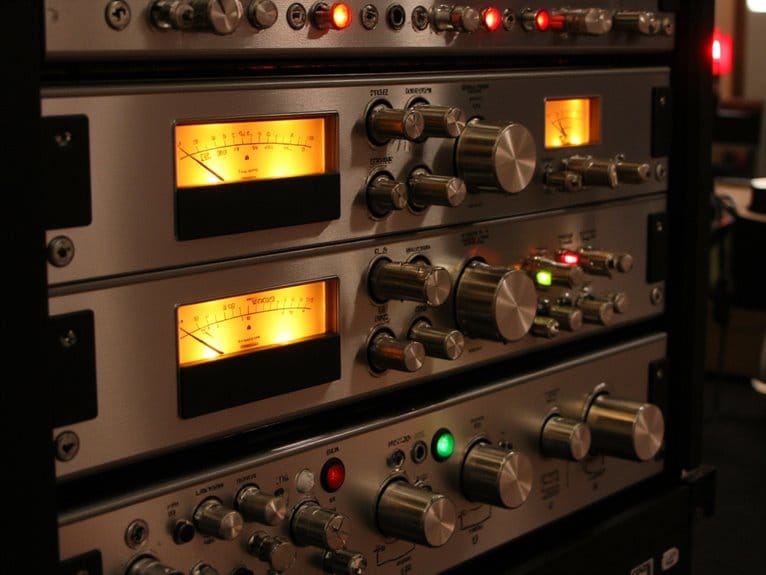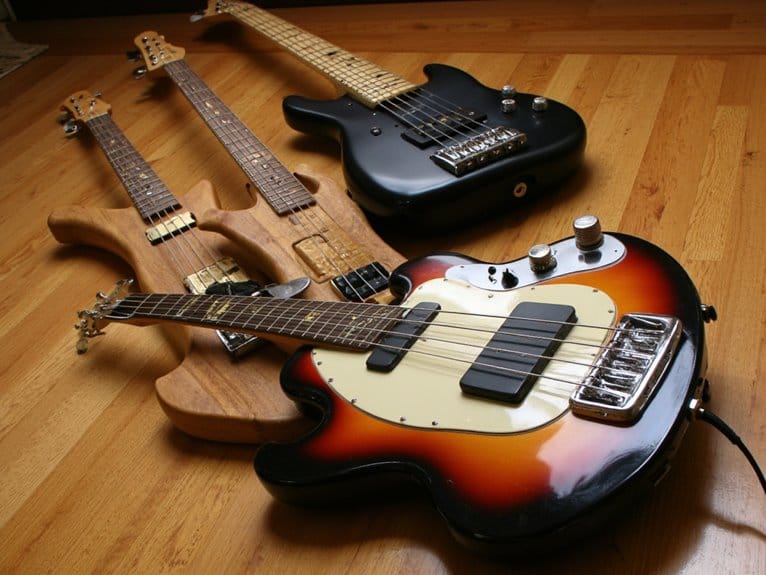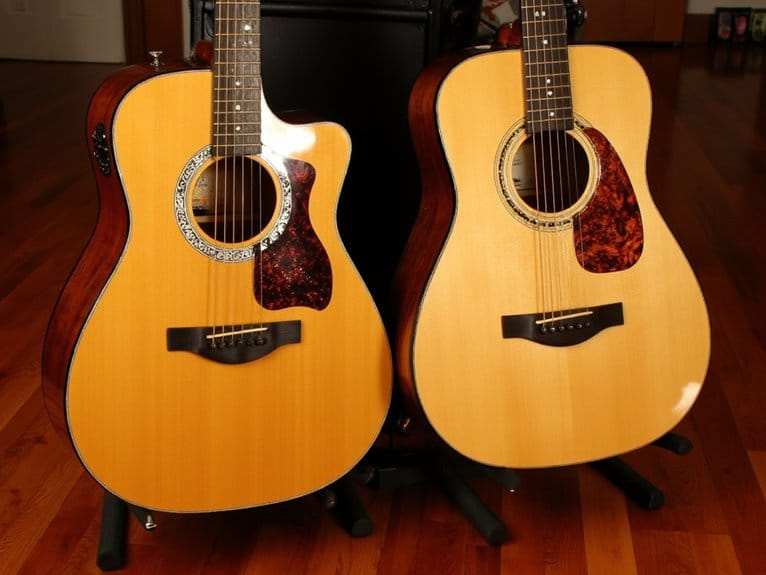Dynamic Processors: Compressors, Limiters and Gates
You’ll master three essential dynamic processors that shape professional audio: compressors control volume fluctuations using threshold, ratio, and attack/release settings to smooth vocal levels and enhance sustain, limiters provide brick-wall peak protection with output ceilings set between -0.1 to -1.0 dBFS to prevent distortion, and gates act as smart volume-based doormen that eliminate background noise like hum and hiss. Each processor serves distinct purposes-compressors for creative control, limiters for safety, gates for cleanup-and choosing the right one depends on your source material, environment, and desired sonic outcome. Understanding their characteristics reveals advanced audio engineering techniques.
We are supported by our audience. When you purchase through links on our site, we may earn an affiliate commission, at no extra cost for you. Learn more.
Notable Insights
- Compressors reduce dynamic range by attenuating signals above a threshold, with controls for ratio, attack, release, and knee characteristics.
- Limiters provide brick-wall peak protection by instantly catching transients, typically with output ceilings set between -0.1 to -1.0 dBFS.
- Gates act as smart doormen, opening and closing based on volume levels to reduce background noise and unwanted sounds.
- Processor selection depends on source material, environment, and desired outcome-whether sustain enhancement, peak protection, or noise elimination.
- Attack and release times are crucial across all processors to maintain transient punch while preventing pumping artifacts.
Understanding Compressor Controls and Characteristics
When I first started working with dynamic processors, I’ll admit the array of knobs and parameters looked intimidating, but understanding compressor controls becomes straightforward once you grasp what each one actually does to your audio signal.
The threshold sets where compression begins, with lower settings affecting more of your dynamic range, while higher thresholds target only peaks. Your ratio determines compression intensity-2:1 offers gentle control, while 10:1 approaches limiting territory.
Attack time controls how quickly compression engages, balancing peak control against preserving transient punch that gives instruments their character. Release time governs recovery speed, preventing unwanted pumping artifacts.
The knee parameter smooths compression onset, with soft knees providing transparency and hard knees delivering obvious control. Mastering these compression techniques transforms chaotic dynamics into polished, professional-sounding audio.
Limiter Applications for Peak Control and Protection
While compressors give you nuanced control over dynamics, limiters serve as your audio’s final line of defense, acting like an uncompromising bouncer that absolutely refuses to let signal peaks exceed your designated ceiling.
I’ve found that peak limiting becomes vital when you’re pushing for maximum loudness without sacrificing audio safety, especially during mastering or live sound applications. You’ll typically set your output ceiling around -0.1 to -1.0 dBFS, creating that essential headroom before digital clipping occurs.
Unlike compressors that gradually reduce gain, limiters apply brick-wall limiting that instantly catches transient peaks, preventing distortion that could damage downstream equipment or cause listener fatigue.
Limiters act as digital guardians, instantly stopping transient peaks before they can cause distortion or equipment damage.
This aggressive approach makes limiters your go-to solution when protection matters more than musical nuance. Professional audio interfaces like RME models feature built-in protection circuits that work alongside your limiting strategy to maintain low latency performance while safeguarding your entire signal chain.
Gate Operation for Noise Reduction and Signal Management
The humble noise gate operates like a smart doorman for your audio signal, automatically opening and closing based on volume levels to keep unwanted noise from crashing your mix. When your input signal exceeds the threshold setting, the gate opens completely, allowing clean audio to pass through unimpeded. Once levels drop below that threshold, it closes and attenuates unwanted background noise like hum, hiss, or equipment buzz.
Proper gate parameters make all the difference in effective noise reduction.
You’ll want to dial in attack times fast enough to catch transients, while release settings should preserve natural decay characteristics. The threshold needs careful adjustment-too high and you’ll cut off quiet passages, too low and noise bleeds through, defeating the purpose entirely.
Choosing the Right Processor for Your Audio Needs
Selecting the ideal dynamic processor for your specific audio situation isn’t rocket science, but it does require understanding what each tool brings to the table and matching those capabilities to your actual needs.
Your processor selection hinges on identifying the primary problem you’re solving. When dealing with inconsistent vocal levels or instruments with wide dynamic swings, compressors smooth out those variations while maintaining natural character. For preventing distortion and protecting equipment, limiters act as safety nets with their brick-wall approach to peak control.
Smart processor selection starts with problem identification: compressors tame inconsistent levels naturally while limiters provide brick-wall peak protection.
Consider these key factors when making your audio context decision:
- Source material characteristics – vocals need gentle compression, drums benefit from aggressive limiting
- Environment requirements – live sound demands protective limiting, studio work allows creative compression
- Desired sonic outcome – sustain enhancement versus peak protection versus noise elimination
- Signal chain position – individual tracks, mix buses, or mastering stages
On a final note
You’ve now got the foundation to tackle dynamic processing with confidence, whether you’re taming aggressive vocals with compression, protecting your speakers through limiting, or cleaning up noisy recordings with gates. I’ll admit, choosing between these processors can feel overwhelming at first, but remember that each serves distinct purposes in your signal chain. Start with basic settings, trust your ears over meters, and don’t be afraid to experiment-you’ll develop instincts for when compression enhances musicality versus when limiting becomes essential for peak management.







